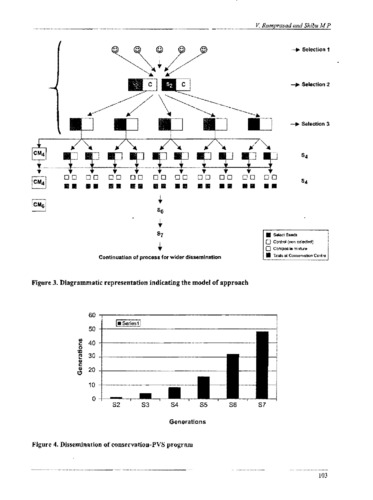Varietal improvement and dissemination by Ksatsart University, the Thai Tapioca Development Institute and the Dept. of Agricultural Extension
For decades a cassava yield stagnation has been observed in Thailand. In addition, current prices of cassava roots and products are highly fluctuating, as they depend on the European Union market's price of cereals, the subsidy of which will be relaxed and will soon disappear. Since 1992 the Thai government has been implementing a policy of reducing the cultivated area, while maintaining the quality and total production of cassava, by the replacement of the traditional local variety, Rayong 1 , by higher yielding new varieties. The objective of this paper is to describe the varietal improvement of cassava by Kasetsart University (KU), as well as the cooperative multiplication and dissemination of new, improved cultivars to farmers by KU, the Thai Tapioca Development Institute (TTDI) and the Department of Agricultural Extension (DOAE). Two popular cassava cultivars, Kasetsart 50 and Rayong 5, were officially released in
1992 and 1994, respectively. Subsequent breeding efforts at KU have concentrated on the cross between Rayong 5 and Kasetsart 50. The preliminary results shows that several F, clones from the cross had potential dry root yields 10-30% higher than those of the parents. These promising clones have harvest indices and root starch contents similar to those of the parents, but have a significantly higher total biological yield.
Regarding varietal dissemination, in 1994 KU produced 750,000 long stems, and in 1995 1.5 million long stems of Kasetsart 50, for the DOAE to distribute to cassava fanners for further multiplication and distribution. Participating farmers received free cassava stems and 15-15-15 fertilizer at the rate of 625 kg/ha. In 1994, the multiplication area was 5,440 ha involving 2,458 farmers from 25 provinces. Additionally, in 1995, there were 3,899 participating farmers from 22 provinces, who multiplied cassava in 6,274 ha.
In 1993, the TTDI was founded as a foundation, with an initial trust fund of US$24 million. Later, in 1995 TTDI cooperated with KU in distributing 1.79 million stems of Kasetsart 50 to 1,198 cassava farmers from 11 provinces, while 5.97 million stems of Kasetsart 50 and 484,000 stems of Rayong 5 were distributed in 1996 to 4,243 cassava farmers from 23 provinces. Subsequently, in 1995, farmers who planted Kasetsart 50 indicated very satisfactorily performance of this new variety. An average yield of 26.47 t/ha was obtained by 26 surveyed fanners who planted Kasetsart 50, as compared with the national average yield of 14.6 t/ha.

